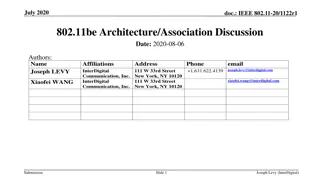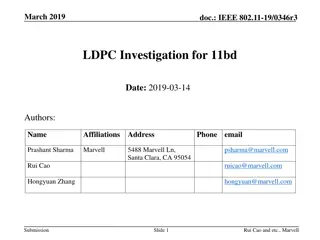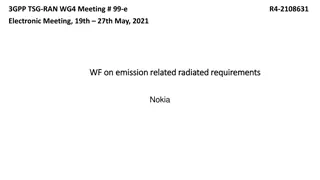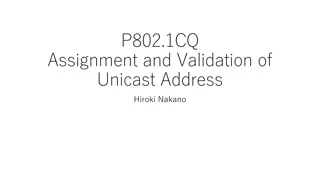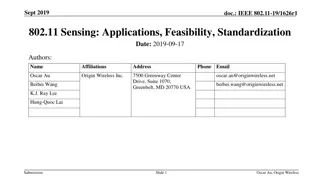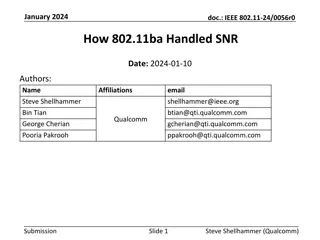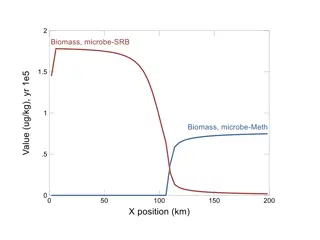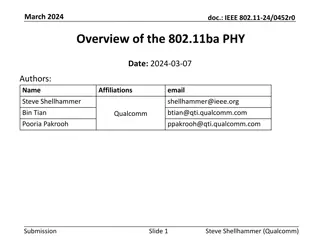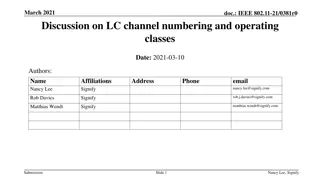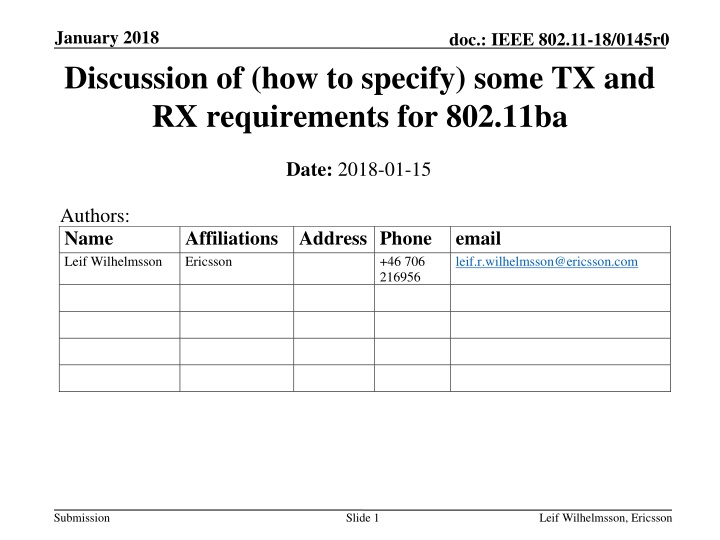
TX and RX Requirements for 802.11ba in January 2018
Discover the key TX and RX requirements for 802.11ba discussed in January 2018, including topics like transmitter spectrum mask, modulation accuracy, and receiver sensitivity. Join the conversation on fulfilling spectrum masks and modulation accuracy for different MCS levels.
Download Presentation

Please find below an Image/Link to download the presentation.
The content on the website is provided AS IS for your information and personal use only. It may not be sold, licensed, or shared on other websites without obtaining consent from the author. If you encounter any issues during the download, it is possible that the publisher has removed the file from their server.
You are allowed to download the files provided on this website for personal or commercial use, subject to the condition that they are used lawfully. All files are the property of their respective owners.
The content on the website is provided AS IS for your information and personal use only. It may not be sold, licensed, or shared on other websites without obtaining consent from the author.
E N D
Presentation Transcript
January 2018 Discussion of (how to specify) some TX and RX requirements for 802.11ba doc.: IEEE 802.11-18/0145r0 Date: 2018-01-15 Authors: Name Leif Wilhelmsson Affiliations Address Phone Ericsson email leif.r.wilhelmsson@ericsson.com +46 706 216956 Submission Slide 1 Leif Wilhelmsson, Ericsson
January 2018 doc.: IEEE 802.11-18/0145r0 Abstract When working on the PHY specification text, we realized we don t have many agreements on TX and RX requirements We also realized that also within this small group we did not have the same view The purpose of this presentation is to discuss some of the key TX and RX requirements and get feedback from the group Submission Slide 2 Leif Wilhelmsson, Ericsson
January 2018 doc.: IEEE 802.11-18/0145r0 Outline Transmitter Spectrum mask Modulation accuracy Receiver Receiver sensitivity Adjacent channel rejection Maximum input level Submission Slide 3 Leif Wilhelmsson, Ericsson
January 2018 doc.: IEEE 802.11-18/0145r0 Transmitter: Spectrum mask The first question is whether it suffice to fulfill the 20 MHz TX mask for the PCR If the answer is yes, we are done The figures above are just for illustration (OBO = 3 dB, windowing applied (1 sample at 20 MHz)) Submission Slide 4 Leif Wilhelmsson, Ericsson
January 2018 doc.: IEEE 802.11-18/0145r0 Transmitter: Spectrum mask The spectrum becomes dependent on the selected waveforms selected for the ON part of the signal, above is one example Should we have different spectrum masks for MCS0 and MCS1, or just one that should be fulfilled for both? MCS1 expected to generate wider spectrum Details TBD once the waveforms are decided Submission Slide 5 Leif Wilhelmsson, Ericsson
January 2018 doc.: IEEE 802.11-18/0145r0 Transmitter: Modulation accuracy This is where EVM is used in e.g. 802.11ac Since the receiver is non-coherent, one may use a similar measure as is done to test an FSK transmitter, i.e., considering an ideal eye-diagram The figure above is taken from the Bluetooth spec. Submission Slide 6 Leif Wilhelmsson, Ericsson
January 2018 doc.: IEEE 802.11-18/0145r0 Transmitter: Modulation Accuracy Possible requirements for modulation accuracy: Zero-crossing error (TBD us) Max eye-opening ( > TBD % of ideal eye-opening) Submission Slide 7 Leif Wilhelmsson, Ericsson
January 2018 doc.: IEEE 802.11-18/0145r0 Transmitter: Modulation Accuracy The transmitter should be tested with an ideal receiver . Possible requirements for such a receiver: Operating at 20 MHz Using a CSF of 2.5 MHz (LPF) Digital detector using a FIR filter Ideal frequency generation (no frequency offset and no phase noise) Submission Slide 8 Leif Wilhelmsson, Ericsson
January 2018 doc.: IEEE 802.11-18/0145r0 Receiver: Sensitivity According to the PAR The WUR is a companion radio to the primary connectivity radio and meets the same range requirement as the primary connectivity radio Because of different regulatory rules in different regions of the world, the maximum allowed TX power may be different than that of the PCR [1] To achieve the same range when the TX power is less for the WUR, a better sensitivity is required Submission Slide 9 Leif Wilhelmsson, Ericsson
January 2018 doc.: IEEE 802.11-18/0145r0 Alternative 1: Just consider AWGN. To have the same range, the sensitivity requirements must take a reduced TX power into account. PCR requirement is -82dBm TX power may be 7 dB less in 5 GHz => WUR sensitivity should be -89 dBm Submission Slide 10 Leif Wilhelmsson, Ericsson
January 2018 doc.: IEEE 802.11-18/0145r0 Alternative 2: Just consider AWGN. To have the same range, the sensitivity requirements must take a reduced TX power into account. PCR requirement is -82dBm The PAR does not say that the WUR must use the same band, so the WUR may use 2.4 GHz instead TX power may be 4 dB less in 2.4 GHz => WUR sensitivity should be -86 dBm Note: Arguing that PCR is in 5 GHz and WUR may be in 2.4 does not seem appropriate. There may be a reason why PCR is not in 2.4 GHz Submission Slide 11 Leif Wilhelmsson, Ericsson
January 2018 doc.: IEEE 802.11-18/0145r0 Alternative 3: When range is discussed in the PAR, one should interpret this as the range for a functional link, i.e., there must also be an UL using the PCR Assuming that the TX power for the non-AP is considerably less, the UL may anyway set the limit WUR TX power is 16 dBm, if the non-AP STA does not have more than this, WUR may also have -82dBm as sensitivity Note 1: This would effectively mean that we start differentiating between APs and non-AP STAs, similar to cellular system. Note 2: This relies on different TX power, but this does not have to be the case Submission Slide 12 Leif Wilhelmsson, Ericsson
January 2018 doc.: IEEE 802.11-18/0145r0 Alternative 4: The requirement in the specification is one thing, what is achieve in products something else Say all products on the market have a sensitivity of at least -92dBm Specifying WUR sensitivity to -89 is then no issue if we are serious with that the products should have the same range. In fact the WUR must be better than -89 dBm anyway Submission Slide 13 Leif Wilhelmsson, Ericsson
January 2018 doc.: IEEE 802.11-18/0145r0 Alternative 5: The real world is not AWGN, but a 4 MHz signal will have a disadvantage because of worse frequency selectivity If the same sensitivity is intended to mean same range for the end user, one may want to introduce means to address this Specifying for something else than AWGN is not done in 802.11, but then the whole set-up with a companion radio with a different bandwidth has never been discussed before One can still test for AWGN, but agree on a addition fading margin that is needed for the WUR Slide 14 Submission Leif Wilhelmsson, Ericsson
January 2018 doc.: IEEE 802.11-18/0145r0 Receiver: Sensitivity Note that if one would target -82 dBm, the whole exercise done up until now regarding MCS is missing the target. -82dBm likely means that 62.5 kb/s is not needed Submission Slide 15 Leif Wilhelmsson, Ericsson
January 2018 doc.: IEEE 802.11-18/0145r0 Receiver: Adjacent channel rejection If the Wake-up signal would be transmitted in the center of the 20 MHz channel, it seems ACR would refer to suppressing an adjacent standard Wi-Fi channel 20 MHz away If the Wake-up signal also can be located elsewhere in the 20 MHz channel, the ACR should be specified with a Wi-Fi channel correspondingly closer Submission Slide 16 Leif Wilhelmsson, Ericsson
January 2018 doc.: IEEE 802.11-18/0145r0 Adjacent channel rejection The main radio has ACR = 16dB (ACI = -16dB) for MCS0 The requirement of the ACR should be selected such that it can withstand the same interference power If the received power of the wake-up signal is less than that of the PCR signal, the ACR must be improved correspondingly If the TX power of the wake-up signal e.g. is 7 dB less, then the ACR must be increased by 7 dB, i.e., ACR = 23 dB Submission Slide 17 Leif Wilhelmsson, Ericsson
January 2018 doc.: IEEE 802.11-18/0145r0 Adjacent channel rejection: illustration TX power 23 dBm TX power Pathloss Pathloss RX power RX power C/I C/I Interference PCR WUR Submission Slide 18 Leif Wilhelmsson, Ericsson
January 2018 doc.: IEEE 802.11-18/0145r0 Maximum input level The 802.11 specification requires -30dBm OOK would typically be less sensitive to compression in the front-end Unless there is a use case that require more stringent requirements, the suggestion is to also have -30 dBm for the WUR Submission Slide 19 Leif Wilhelmsson, Ericsson
January 2018 doc.: IEEE 802.11-18/0145r0 Straw Poll 1 Do you believe the transmitter spectrum mask should be the same as today used for 20 MHz 802.11ac (The alternative is one that is more matched to the 4 MHz wake-up signal)? Y/N/A: Submission Slide 20 Leif Wilhelmsson, Ericsson
January 2018 doc.: IEEE 802.11-18/0145r0 Straw Poll 2 Do you support the idea of specifying the transmitter accuracy by means of an eye-diagram? Exactly how is TBD, but a possibility would be to specify zero- crossings and max eye-opening as discussed in this presentation Y/N/A: Submission Slide 21 Leif Wilhelmsson, Ericsson
January 2018 doc.: IEEE 802.11-18/0145r0 Straw Poll 3 Do you believe only one sensitivity requirement should be specified, even if this means different relative sensitivities for the PCR and the WUR in different parts of the world? Y/N/A Submission Slide 22 Leif Wilhelmsson, Ericsson
January 2018 doc.: IEEE 802.11-18/0145r0 Straw Poll 4 If only one sensitivity requirement is specified, what is the number you prefer? -82dBm/-86dBm/-89dBm/<-89 dBm/No opinion Submission Slide 23 Leif Wilhelmsson, Ericsson
January 2018 doc.: IEEE 802.11-18/0145r0 Straw Poll 5 Assume that ACR is specified independent of what maximum TX power can be used. What do you believe the ACR for MCS0 should be? 16dB/20dBm/23dBm/No opinion Submission Slide 24 Leif Wilhelmsson, Ericsson
January 2018 doc.: IEEE 802.11-18/0145r0 References [1] S. Shellhammer and B. Tian, Regulations and noise figure - Impact on SNR , IEEE 802.11-17/0365r0. Submission Slide 25 Leif Wilhelmsson, Ericsson






